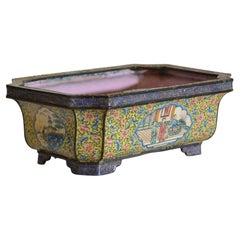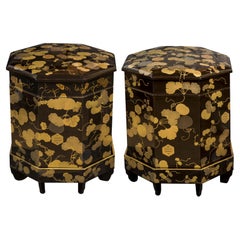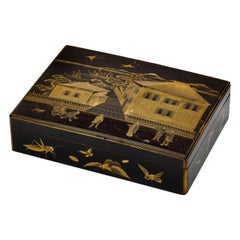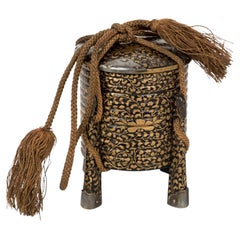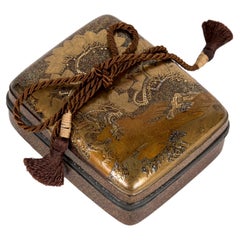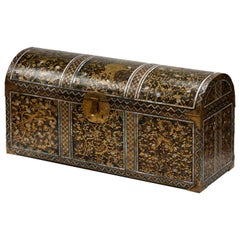Europe - Lacquer
to
4
151
383
148
2
1
3
2
1
1
40
74
34
3
13
10
7
1
1
2
2
3
106
68
46
30
12
136
120
94
26
7
151
150
150
1
1
1
1
1
Item Ships From: Europe
Qianlong Chinese Canton enamel jardinière
Located in Castle Douglas, GB
Qianlong Chinese Canton enamel jardinière
18th century Chinese enamel jardinière, bonsai planter. Rectangular with canted corners of caveto form, the frieze decorated with Greek ke...
Category
18th Century Chinese Antique Europe - Lacquer
Materials
Enamel
Japanese Black and Gold Lacquer Kaioke Boxes 'Hokaibako'
Located in PARIS, FR
Two big eight-sided kaioke boxes in black lacquer, decorated with mon and maple leaves in golden lacquer.
These are usually octagonal boxes containing the painted shells used in ...
Category
Late 19th Century Japanese Antique Europe - Lacquer
Materials
Lacquer
A Japanese export lacquer box with depiction of the Grand Hotel, Yokohama
Located in Amsterdam, NL
Meiji period, circa 1873-1887
The black lacquered box decorated in maki-e and hiramaki-e gold, with on the lid a European style building complex and several Japanese and European figures walking along a street in the foreground. The sides are finely decorated with several insects and the inside with several compartments and nashiji decoration.
H. 7.4 x W. 29 x D. 25.7 cm
After the Americans forced Japan to open their harbours to the outside world and take part in international treaty and trade around the mid 19th century, the formerly feudal society rapidly changed. Japan was now focussing on an industrial future. One of the major international ports was Yokohama with its foreign embassies and warehouses - which attracted a great number of visitors of all sorts. For the higher society visiting Japan for the first time a new and ‘Western’ hotel had to be realised; hence the construction of The Grand Hotel on Kaigandori.
The hotel was opened on August 16, 1873 (Meiji 6) and was soon considered the height of Western culture and elegance in Japan. The building probably depicted on this box, designed by American architect Richard P. Bridgens (リチャード・ブリジェンス, 1819 -1891), is the original hotel...
Category
19th Century Japanese Antique Europe - Lacquer
Materials
Gold
Miniature hokkai bako or kaioke, doll furniture replica of a traditional box
Located in PARIS, FR
Small hokkai bako or kaioke seashells game box, of circular form with its four feet, its bronzes and cordon, decorated with a motive of flowers of gold lacquer on a black lacquer bac...
Category
Late 19th Century Japanese Meiji Antique Europe - Lacquer
Materials
Gold, Bronze
Japanese landscape pine kobako box Edo period 18th century
Located in PARIS, FR
Rectangular black and gold lacquer kobako box decorated with pine trees in a mountain landscape in takamaki-e, kirigane and hiramaki-e lacquer. Background in nashi-ji lacquer. Surmou...
Category
18th Century Japanese Antique Europe - Lacquer
Materials
Gold
Large Japanese Namban Lacquer Coffer Arqueta, 16th Century
Located in Amsterdam, NL
A large Japanese Namban lacquer arqueta coffer for the Portuguese market
Kyoto, Momoyama-period, late 16th century
In Hinoki cypress lacquered in ...
Category
16th Century Japanese Antique Europe - Lacquer
Materials
Mother-of-Pearl, Wood
Japanese Bundai or writting table in gold lacquer with a decor of lake landscape
Located in PARIS, FR
Rectangular bundai writing table on four legs in gold lacquer with black highlights on a nashi-ji background. The top is decorated with a lake landscape with plum trees, pine trees a...
Category
Early 18th Century Japanese Edo Antique Europe - Lacquer
Materials
Gold, Bronze
Rare 17th Century Japanese Export Lacquer Medical Instrument Box
Located in Amsterdam, NL
A rare Japanese export lacquer medical instrument box
Edo-period, 1650-1700
L. 19 x W. 6 x H. 8.5 cm
This unconventionally shaped lacquer b...
Category
17th Century Japanese Edo Antique Europe - Lacquer
Materials
Gold
Rare 19th Century Chinoiserie Black Lacquer Box, c. 1850
Located in Richmond, London
A large and very rare Chinese export black lacquer box, exquisitely gilt-decorated with whimsical oriental motifs. Chinese, Canton, Qing dynasty, ...
Category
19th Century Asian Chinese Export Antique Europe - Lacquer
Materials
Lacquer, Wood
XX°Century Chinese Decorative Screen Lacquered whit Landscape and Sails
Located in Brescia, IT
Chinese screen in black lacquered wood decorated with gilded paintings, very sturdy with excellent wooden base.
Category
20th Century Chinese Chinese Export Europe - Lacquer
Materials
Giltwood, Lacquer, Wood
Unique 17th Century Miniature Japanese Namban Lacquer Miniature Dollhouse Chest
Located in Amsterdam, NL
A unique and exceptional Japanese miniature or dollhouse export lacquered chest
Kyoto, circa 1620-1640
The chest of rectangular shape with a domed lid, decorated in Transition-style, in gold hiramaki-e on a black background within reserved lobed cartouches decorated with landscapes animated with birds and rabbits, on a shagreen or samegawa background. The borders are decorated with geometric friezes, the box with gilt-copper mounts, the interior decorated in red lacquer.
Measures: H 9.2 x W 14.5 x D 7.2 cm
This miniature is of exceptional quality and a perfect copy of the famous large size Transition-style coffers. It was most likely ordered by a Dutch lady for her dollhouse (poppenhuis), like the famous Petronella Oortman (1656-1716) doll-house, which is now one of the highlights in the collection of the Rijksmuseum Amsterdam, or Petronella Oortmans-de la Court’s (1624-1707) dollhouse in the collection of the Centraal Museum Utrecht. Sara Rothé of Amsterdam in 1743 ordered a miniature black lacquered ivory tripod table with gold chinoiserie decoration by Jurriaan Buttner (Monika Kopplin, European Lacquer, 2010, p. 56).
Other Japanned dollhouse...
Category
17th Century Japanese Edo Antique Europe - Lacquer
Materials
Shagreen, Cypress
Fine Japanese Black and Gold Lacquer Sageju-Bako - Picnic Box
Located in PARIS, FR
Black and gold lacquer sageju-bako (picnic box) decorated with floral motifs in hiramaki-e. It includes a sake bottle, a four-compartment box with nashi-ji lacquer inside, a simple tray and a hollow tray. At the top, there is a bronze handle for transport.
The sageju-bako is divided into four superimposed boxes for food on the left; a simple tray, a sake bottle and a hollow tray on the right. They are in the shape of a plum blossom.
On the top, on both sides a phoenix. The phoenix (hôo) has an imperial and solar symbolism. This auspicious bird also embodies virtues taken from the teachings of Confucius (such as goodness, righteousness and wisdom).
The left boxes are patterned with turtles, plum tree, bamboo, cherry blossoms, water plantains near rivers. The two trays on the right have a shell and seaweed pattern. The sake bottle is decorated with a plum tree and bamboo.
On the sides, calabash decoration. Borders in saya (or sayagata) pattern, composed of Chinese swastikas...
Category
Early 19th Century Japanese Antique Europe - Lacquer
Materials
Lacquer
Gold Lacquer Inro Decorated with a Lake Landscape
Located in PARIS, FR
Inro with four gold lacquer boxes, decorated with a lake landscape. Accompanied by a bronze ryusa manju.
Small boxes formed of compartments that fit one on top of the other, inro (? ?) are traditional Japanese clothing...
Category
Mid-19th Century Antique Europe - Lacquer
Materials
Lacquer
Inro in black and gold lacquer with a proeminent chrysantemum flower motive
Located in PARIS, FR
Two compartments inrô in black lacquer, hira maki-e and mother-of-pearl inlay on a hirameiji background, decorated with a bouquet of chrysanthemums in a small purse, a hoe on the other side, and a fluttering butterfly which can be found on both sides. The interior is in hirameiji lacquer. The ojime is a drum made out of black lacquer and ivory with a mother-of-pearl inlay. The Manjû netsuke...
Category
Mid-18th Century Japanese Edo Antique Europe - Lacquer
Materials
Gold
Japanese Edo Period Black & Gold 'Nagamochi' Dowry Trunk with Family Crests
Located in London, GB
A Fine Black & Gold Lacquer
Japanese Nagamochi Trunk
With Family Crests of the Tokugawa and Minamoto Clans
Of rectangular form, the storage trunk covered on all sides with hiramak...
Category
19th Century Japanese Edo Antique Europe - Lacquer
Materials
Lacquer
Japanese lacquered Inro chrysantemum
Located in PARIS, FR
Beautifull Inro of three compartments made in kinji lacquer with an hiro maki-e
ornament chrysanthemum flowers of gold and silver lacquer. Inside is in fundame
lacquer.
Signed by J...
Category
Mid-18th Century Japanese Antique Europe - Lacquer
Materials
Lacquer
Japanese Export Nagasaki Lacquer Box with the Portrait of Napoleon Bonaparte
Located in Amsterdam, NL
A Japanese export Nagasaki lacquer tobacco box with the portrait of Napoleon Bonaparte
Edo-period, circa 1810
The box in black lacquer on copper, ...
Category
19th Century Japanese Edo Antique Europe - Lacquer
Materials
Copper, Gold
A small Japanese export lacquer circular box with a depiction of the Muiderpoort
Located in Amsterdam, NL
Nagasaki, Edo period, 1st half 19th century
Of circular form decorated in gold hiramaki-e on a black-lacquered ground, the lid depicts the Muiderpoort, a city gate of Amsterdam, aft...
Category
19th Century Japanese Antique Europe - Lacquer
Materials
Lacquer
Japanese peony basket lacquered box Edo
Located in PARIS, FR
Eight-sided, flared shaped lacquer kobako box, following the decoration on the lid depicting a basket of flowers, composed of peonies and chrysanthemums in gold takamaki-e and hirama...
Category
18th Century Japanese Edo Antique Europe - Lacquer
Materials
Gold
Inro in gold kinji lacquer representing chrysantemum flowers on all sides
Located in PARIS, FR
Beautifull Inro of three compartments made in kinji lacquer with an hiro maki-e ornament chrysanthemum flowers of gold and silver lacquer. Inside is in fundame lacquer.
Signed by Josen Zo and stamped by Seisan
Presented with an Ojime in metal in the shape of a chrysanthemum flower and with its netsuke representing two chrysanthemum flower buds.
The chrysanthemum (kiku) in not only the heraldic symbol of the Japanese imperial family...
Category
Early 19th Century Asian Edo Antique Europe - Lacquer
Materials
Lacquer
An oval Japanese export lacquer tray
Located in Amsterdam, NL
An oval Japanese export lacquer tray decorated with the alliance of the coats of arms of the Mooyaart and Pauw families
Edo-period, circa 1798
L. 51.5 x B. 37.5 x H.3.2 cm
This tra...
Category
18th Century Japanese Antique Europe - Lacquer
Materials
Lacquer
Japanese inro of the edo period adorned with a landscape houses near a lake
Located in PARIS, FR
Inrō with four gold lacquer compartments, decorated with a lake landscape. Accompanied by a bronze ryusa manju.
Small boxes formed of compartments that fit one on top of the other, i...
Category
Late 18th Century Japanese Edo Antique Europe - Lacquer
Materials
Gold
Black and Gold Lacquer Suzuribako 'Writing Set'
Located in PARIS, FR
Black and gold lacquer suzuribako (writing set) in takamaki-e on a nashi-ji background representing two tigers near rocks, bamboos and plum blossoms in a night landscape. Inside of the lid with a lake landscape.
The interior of the suzuribako is composed with an inkstone, topped by a copper water bucket in the shape of a chrysanthemum on the left side, with a brush and a small knife. It includes in the right part a storage compartment.
Inscription under the inkstone "Inkstone made by Nakamura Chobe".
Although the tiger is not native to Japan, it has a high symbolic. The figure of courage was introduced by Buddhism from China. According to the Chinese tradition, the tiger is from one of the stars of the Great...
Category
Late 18th Century Japanese Antique Europe - Lacquer
Materials
Lacquer
Fine Japanese Export Red Lacquer Box with Masonic Symbols, circa 1800
Located in Amsterdam, NL
A fine Japanese export red lacquer box with Masonic symbols
Kyoto/Nagasaki, 1800-1820
Red lacquer decorated with scattered flowers and flying birds with long tails in gold, wit...
Category
Early 19th Century Japanese Edo Antique Europe - Lacquer
Materials
Gold
Extremely Japanese Rare Lacquer Plaque Depicting Russian St. Petersburg
Located in Amsterdam, NL
An important Japanese lacquer Maki-É Panel Depicting St. Petersburg on the River Neva, with the winter palace on the left and the academy of science on the right, 18th century.
Nagasaki, 1780-1800
In black lacquer on copper, the front decorated in maki-é, the back inscribed, Vue Perspective des Bords de la Neva en descendant la Rivière entre le Palais d'hyver de sa Majesté Impériale et les batiments de l'Académie des Sciences à St Petersburg in gold and inlaid with flowers in mother of pearl.
Measures: H 23 x W 39 cm
The present plaque is identical to one in the Museum of Japanese History in Sakura and another one in the Museum of Peter the Great in St. Petersburg. (see: Oliver Impey & Christiaan Jörg, Japanese Export Lacquer, 1580-1850, p. 52-53)
This last one was given to Catherine the Great in 1794 by the Swedish medical doctor Johan Arnold Stutzer who had served with the VOC in Deshima in 1787-1788. Apparently, such plaques were not unique and may have been made in several copies. This was certainly the case with the smaller lacquer oval portrait medallions (see for instance Uit Verre Streken, June 2017, no. 62)
The scene of St. Petersburg was copied from an optical print taken by Stutzer to Japan, as shown by Yasumasa Oka of the Kobe City Museum. Stutzer in his diary writes: “I am the first to bring them (i.e. the Japanese) original pictures such as a view of St Petersburg and of Rudolf XV on horseback and try to have them made (in lacquer). According to the Japanese, it is the first time that these two pictures will be copied. Other products that I also ordered, for example, pictures of sea battles, are also appreciated as absolute masterpieces”.
For two lacquered plaques depicting the sea battle of Dogger Bank in 1781 between the Dutch and the English navies, see Uit Verre Streken, December 2013, nr. 39 and March 2015, nr 56. Johan Strutzer at the same time also presented six beautiful Japanese glass telescopes to Catherine the Great of Russia, like the two Japanese glass telescopes illustrated in Uit Verre Streken, March 2015, item 59 and 60 and the one in the Kobe City Museum (illustrated in: Japan Envisions the West, 16th-19th Century Japanese Art...
Category
Late 18th Century Japanese Antique Europe - Lacquer
Materials
Copper
Fine Quality 18" Meiji Japanese Cloisonne Charger Plate - Antique Oriental Décor
Located in Wisbech, Cambridgeshire
Antique 19th Century 18" Meiji Oriental Japanese Cloisonné Charger Plate - Rare Decorative Piece!
This exquisite cloisonné charger plate hails from the 19th century, showcasing fine...
Category
19th Century Antique Europe - Lacquer
Materials
Enamel
$2,666 Sale Price
30% Off
Large Early 19th Century Chinoiserie Black Lacquer Box
Located in Richmond, London
A large early 19th century chinoiserie black lacquer and gilt box of a rare shape. Canton, China, circa 1830.
Why we like them
Exquisite gilt decoration, wonderfully preserved orig...
Category
Early 19th Century Chinese Chinese Export Antique Europe - Lacquer
Materials
Lacquer
Chinese Black Lacquered Wood Box - Imperial Dragons - Ming Period Wanli 17th
Located in Beuzevillette, FR
Magnificent box Imperial jewelry box in black lacquered wood decorated with dragons.
This wonderful box is lacquered on a black background with patt...
Category
17th Century Chinese Ming Antique Europe - Lacquer
Materials
Wood
Japanese Laquered Box with Hinged Lid hand painted, 19th Century Meiji Period
Located in Lincoln, Lincolnshire
This is a good papier mâché, rectangular shaped black lacquered lidded box, hand enamelled and gilded, made in Japan during the 19th century, early Meiji period.
This rectangular shaped papier mâché box has a well fitting hinged lid, with the box base and lid slightly domed. The box was probably originally made as a pocket box but could easily sit on a desk or dressing table as required.
This is a very decorative box with finely hand painted scenes of three people, one holding a parasol, in a garden setting, with a pagoda type building, large gate...
Category
19th Century Japanese Meiji Antique Europe - Lacquer
Materials
Paper
Pair of Japanese Lacquer and Mother-of-Pearl Inlaid Knife Urns, circa 1800-1815
Located in Amsterdam, NL
A rare pair of Kyoto-Nagasaki style lacquer and mother-of-pearl inlaid knife urns
Edo period, early 19th century
Measures: Height 71 x diameter 30 cm
?Formed as urns with vertically lifting covers and elongated finials, revealing fitted green velvet lined interiors for knives, decorated overall with birds, flowering stems, faux-fluting and oval panels with landscapes. The square plinth is raised on four bracket feet. Inside the lifting cover of one of the urns are Japanese characters, supposedly indications of some code by the craftsman.
A closely related knife urn, now in the collection of the Peabody Essex Museum, Salem (inv. E 73115), was acquired in Nagasaki by Captain Samuel Gardner Derby of the Margareth of Salem in 1801. Captain Gardner Derby traded in Nagasaki under charter from the VOC (Vereenigde Oostindische Compagnie), the Dutch East India Company. Between 1797 and 1814 Holland was occupied by the French and from 1811 until 1816 Java by
the English. During these periods practically no Dutch shipping was possible between Holland and Batavia (Jakarta) or between Batavia (Jakarta) and Nagasaki. To maintain a minimum amount of shipping between Batavia (Jakarta) and Nagasaki, between 1797 and 1807, the VOC chartered mainly American ships. American captains and officers ordered and bought mainly lacquered furniture in an American-English style, completely different from what the Dutch up till then had ordered. The present knife urns were possibly also ordered and acquired by Captain Gardner Derby during his stay in Deshima/Nagasaki in 1801.
Another similarly neoclassical shaped knife urn in the collection of the Ashmolean Museum Oxford (inv. 1996.17) appears to be signed by woodworker Kiyotomo koreo tsukuru (Kiyomoto made this). The same name, together with an address in the Sanjo-Teramachi District of Kyoto, has been found inside a fragmentary urn in a private collection. This is an indication that European-style furniture was not only lacquered in Japan but made there as well. This undoubtedly is not only true for knife-urns, but all European- style furniture lacquered in Japan after circa 1800 was made by Japanese furniture makers...
Category
Early 19th Century Japanese Anglo-Japanese Antique Europe - Lacquer
Materials
Brass
Japanese Kobako box in the form of a furoshiki present in gold and black lacquer
Located in PARIS, FR
Rectangular and flat lacquer Kobako (small box) representing a furoshiki knot seen from above. Fundame background, furoshiki in takamaki-e with floral pattern, inside the folds of th...
Category
Late 18th Century Japanese Edo Antique Europe - Lacquer
Materials
Gold
Fabulous Lacquer Pagoda Chinoiserie Sculpture with Original Wooden Box
Located in Amsterdam, NL
Wajima lacquer model of a five story-pagoda by the contemporary lacquer master Miyasaki Masahiro.
In the original signed box, including a wooden disp...
Category
Late 20th Century Japanese Showa Europe - Lacquer
Materials
Lacquer
Chinese Export Lacquered and Mother-of-Pearl Chess Board from 19th with a Table
By Gold China
Located in Madrid, ES
Chinese Export lacquered and mother-of-pearl chess board from 19th with a table carved wood stand.
Size: 58 x 58cm and 73 cm high
Very good condition.
Category
19th Century Chinese Chinese Export Antique Europe - Lacquer
Materials
Wood
Japanese Lacquered Natsume 'Tea Box'
Located in PARIS, FR
Natsume in dark red lacquer, decorated with autumn leaves and cherry blossoms in hiramaki-e and nashiji. Interior in black lacquer.
Maple leaves (Momiji) are celebrated in literatur...
Category
Mid-20th Century Japanese Europe - Lacquer
Materials
Lacquer
Japanese Nagasaki Export Lacquer Box with Depiction of the 'Trippenhuis'
Located in Amsterdam, NL
A Japanese Nagasaki export lacquer box with mother-of-pearl depiction of the Amsterdam ‘Trippenhuis’
Edo-period, circa 1830
H. 12.5 x W. 24...
Category
19th Century Japanese Edo Antique Europe - Lacquer
Materials
Mother-of-Pearl, Lacquer
Two Palembang Peranakan Lacquerware Bridal Boxes and a Tray
Located in Amsterdam, NL
Two Palembang Peranakan lacquerware bridal boxes and a tray
South Sumatra, Palembang, lacquer work by Chinese Peranakan artisans, mid 20th century
Woo...
Category
1950s Indonesian Vintage Europe - Lacquer
Materials
Wood, Lacquer
Japanese Lacquered Furoshiki Kobako 'Box'
Located in PARIS, FR
Rectangular and flat lacquer Kobako (small box) representing a furoshiki knot seen from above. Fundame background, furoshiki in takamaki-e with floral pattern, inside the folds of the fabric with black and gold sayagata pattern with togidashi maki-e technique. The saya (or sayagata) pattern is composed of Chinese swastikas...
Category
Late 19th Century Japanese Antique Europe - Lacquer
Materials
Lacquer
Lacquer inro, Japanese, Late 19th c.
Located in Stockholm, SE
A fourpart Japanese lacquer Inro. the lacquer is red with motives of a spider with its web in gold and two flying cranes. The lowest part of the inro has a crack on one side.
Category
Late 19th Century Japanese Antique Europe - Lacquer
Materials
Lacquer
Japanese golden kobako flowers Edo period 18th century
Located in PARIS, FR
Quadrangular kobako box decorated with flowers in gold and blue lacquer with aogai inlay. Lid and sides in fundame lacquer, underside and interio...
Category
18th Century Japanese Japonisme Antique Europe - Lacquer
Materials
Gold
1800s Russian Lacquer Box Philosopher
Located in Vienna, AT
In this ad you get the chance to buy a beautiful hand-painted Russian lacquer box from the 1800s. It is cylindrical in shape, slightly curving in...
Category
18th Century Russian Antique Europe - Lacquer
Materials
Bentwood
Japanese Colonial Nagsaki Lacquer Box with Depiction of Amsterdam, 1830-1840
Located in Amsterdam, NL
An important Japanese lacquer box with a view of The 'Nieuwe Stadsherberg Van Amsterdam
Nagasaki, Edo-period, 1830-1840
The black lacquered wood box, decorated in gold and inla...
Category
Early 19th Century Japanese Antique Europe - Lacquer
Materials
Mother-of-Pearl, Wood
Pair of Edo Period Black and Gold Lacquer Samurai Helmet Boxes
Located in Lymington, Hampshire
A pair of Edo period black and gold lacquer Samurai helmet boxes (Hakko Bako), each of ribbed cylindrical form with a lid, a black lacquer interior,...
Category
19th Century Japanese Edo Antique Europe - Lacquer
Materials
Lacquer
Wakasa-Nuri Lacquer Bundai, Ryoshobako, Fubako Set
Located in PARIS, FR
Set of bundai, ryoshibako and fudebako in wakasa lacquer with an old rose background and black traditional Japanese patterns.
The saya pattern (or sayagata) is composed by Chinese svastikas. This symbol linked to Buddhism, mean intelligence, power and peace. It is a good omen sign.
The kanoko pattern reminds stains on fawn back.
The sakura (cherry blossom) pattern is emblematic of Japan. The blossoming in a short time marks spring beginning and is a symbol of renewal and ephemeral beauty.
There are also traces of calligraphy brush, in reference to the function of the objects.
Bundai is a low table used to put books or scrolls and, later, to write.
Rectangular ryoshibako (letter and document box) with a slightly domed
Fudebako (pencil case) of rectangular format very narrow in its length with two rounded corners, flat cover.
Wakasa lacquerware...
Category
Early 20th Century Japanese Europe - Lacquer
Materials
Lacquer
Japanese Antique Lacquer Natsume (box for matcha powder) Automne Flowers 1980s
Located in Paris, FR
This is a box for the matcha powder using while tea ceremony in Japan.
It is called 'Natsume'. It is made with wood. The design is some automne flowers and it is all hand painted. Th...
Category
1980s Japanese Showa Vintage Europe - Lacquer
Materials
Wood, Lacquer
A Large Hand Painted Qajar Lacquer Cashier Box, 19th Century
Located in London, GB
A stunning cashier box from the Qajar era, adorned with a lovely red lacquer finish, and floral designs all around the box.
Category
19th Century Asian Antique Europe - Lacquer
Materials
Lacquer
Japanese lacquer tebako 手箱 (box for personal accessories) with book design
Located in Amsterdam, NL
Superb rectangular black lacquer tebako (box for personal accessories) with a slightly domed well-fitted lid.
The lid has a continuous soft-tone multicoloured hiramaki-e (low-relief...
Category
Early 20th Century Japanese Europe - Lacquer
Materials
Lacquer
19th Century Red Lacquer Folding Chair China Round Back Chair
Located in Epfach, DE
The Chinese folding chair was made in the beginning of the 19th century. It is worked out very beautiful and the red lacquer is in a good conditi...
Category
Early 19th Century Chinese Antique Europe - Lacquer
Materials
Leather, Wood
Japanese Antique Lacquer Natsume (box for matcha powder) Red Boat 1980s
Located in Paris, FR
This is a box for the matcha powder using while tea ceremony in Japan.
It is called 'Natsume'. It is made with wood. The design is a boat and it is hand painted. The material is with...
Category
1980s Japanese Showa Vintage Europe - Lacquer
Materials
Wood, Lacquer
Japanese lacquered 5-tiered jûbako 重箱 (picnic box) with banana leaf design
Located in Amsterdam, NL
Elegant lacquered tiered jûbako (picnic box) comprising five stackable tiers, two covers, and a raised tray. Each bearing an attractive deep chestnut brown ground and lacquered in ta...
Category
Early 20th Century Japanese Europe - Lacquer
Materials
Giltwood, Lacquer
Fine 17th Century Japanese Export Black and Gold Lacquered Pictorial-Style Dish
Located in Amsterdam, NL
A fine Japanese export black and gold lacquered pictorial-style dish Nagasaki or Kyoto, 1680-1720
The dish with wide flat rim of Keaki wood (Zelkova species) in black lacquer with...
Category
17th Century Japanese Edo Antique Europe - Lacquer
Materials
Gold
Chinese Gold and Black Lacquer Games Box, Early 19th Century
Located in Bishop's Stortford, Hertfordshire
An exceptional antique Chinese gold and black lacquer games box raised on four paw feet with a domed lift off cover decorated with figural landscape panels in gilded lacquer colours on a black ground. The cover lifts off to reveal five lidded removable counter boxes...
Category
Early 19th Century Chinese Antique Europe - Lacquer
Materials
Lacquer
$2,997 Sale Price
20% Off
Japanese Antique Lacquer Natsume (box for matcha powder) Plum 'UME' 1980s
Located in Paris, FR
This is a box for the matcha powder using while tea ceremony in Japan.
It is called 'Natsume'. It is made with wood. The design is plums (Japanese apricot 'UME') and it is hand paint...
Category
1980s Japanese Showa Vintage Europe - Lacquer
Materials
Wood, Lacquer
Japanese suzuribako lacquered box peony river
Located in PARIS, FR
Suzuribako box (empty) in black lacquer. Gold maki-e decoration of a river bordered by peonies, one with red highlights. The edges of the lid are in gold lacquer. Nashi-ji interior.
Category
Late 19th Century Japanese Antique Europe - Lacquer
Materials
Gold
Small red lacquered Japanese box with royal motto of the Netherlands, 1880
Located in Beuzevillette, FR
Pretty little Japanese lacquered box.
On a golden metal medal inside we can read the royal motto of the Netherlands, adorned with a lion: "Je maintiendrai...
Category
Late 19th Century Japanese Antique Europe - Lacquer
Materials
Wood
Chinoiserie Screen Art Deco Style in Colour China Red and Black Lacquer
Located in Hamburg, DE
Chinese Paravent, Art Deco style, China red lacker, main frame in black lacquer, base material wood, can be used as room divider as back side as a dec...
Category
1920s Chinese Art Deco Vintage Europe - Lacquer
Materials
Wood
Rare 19th Century Qing Dynasty Armorial Lacquer and Gilt Framed Panel
Located in Richmond, London
An extremely rare and superbly decorative Chinese export black lacquer panel, exquisitely gilt-decorated with figures, pagodas and emblazoned with a coat of arms, also displaying mot...
Category
1810s Chinese Chinese Export Antique Europe - Lacquer
Materials
Wood, Lacquer
Japanese Sagemono Inro box with a maki-e decor of a Samuari in a lake landscape
Located in PARIS, FR
Inrô in gilded lacquer according to the takamaki-e, hiramaki-e and kirigane techniques, with five squares of a mountain lake landscape.
On the first side, there is a man on horsebac...
Category
18th Century Japanese Edo Antique Europe - Lacquer
Materials
Gold
Japanese lacquer oblong storage box by Hiroshi Hayashi 林宏 (1967)
By Hiroshi Hayashi
Located in Amsterdam, NL
An exceptional, oblong lacquer 3-tiered storage box with cover, reminiscent of a bento box, by Hiroshi Hayashi (1967). Covered in shiny gold and black l...
Category
21st Century and Contemporary Japanese Europe - Lacquer
Materials
Silk, Wood, Lacquer
Japan Red Lacquered Box 19th century
Located in Beuzevillette, FR
Beautiful Japanese box in red lacquered wood.
The lid is decorated with golden herons and flowering tree branches and signed by the artist. Black flowers are painted around the box.
...
Category
Late 19th Century Antique Europe - Lacquer
Materials
Wood
Japanese 'double gourd' lacquer suzuri’bako (writing box) by Hara Yôyûsai 原羊遊斎
By Hara Yôyûsai
Located in Amsterdam, NL
An uniquely double-gourd-shaped lacquer suzuri’bako (writing box) with a design of gourd leaves, by Hara Yôyûsai (1769-1845).
Covered with amber coloured l...
Category
Early 19th Century Japanese Antique Europe - Lacquer
Materials
Bronze
Recently Viewed
View AllMore Ways To Browse
Nagasaki Lacquer
Negoro Lacquer
Japanese Cinnabar
Japanese Lacquer Comb
Japanese Sake Set Antique
Lacquer Hibachi
Cinnabar Dragon
Japanese Bako
Antique Japanese Lacquer Kobako
Burmese Offering Bowl
Japanese Negoro Lacquer
Japanese Hat Box
Chinese Cinnabar Dragons
Japanese Laquered
Japanese Water Droppers
Namban Lacquer
Japanese Ojime
Japanese Suzuribako
